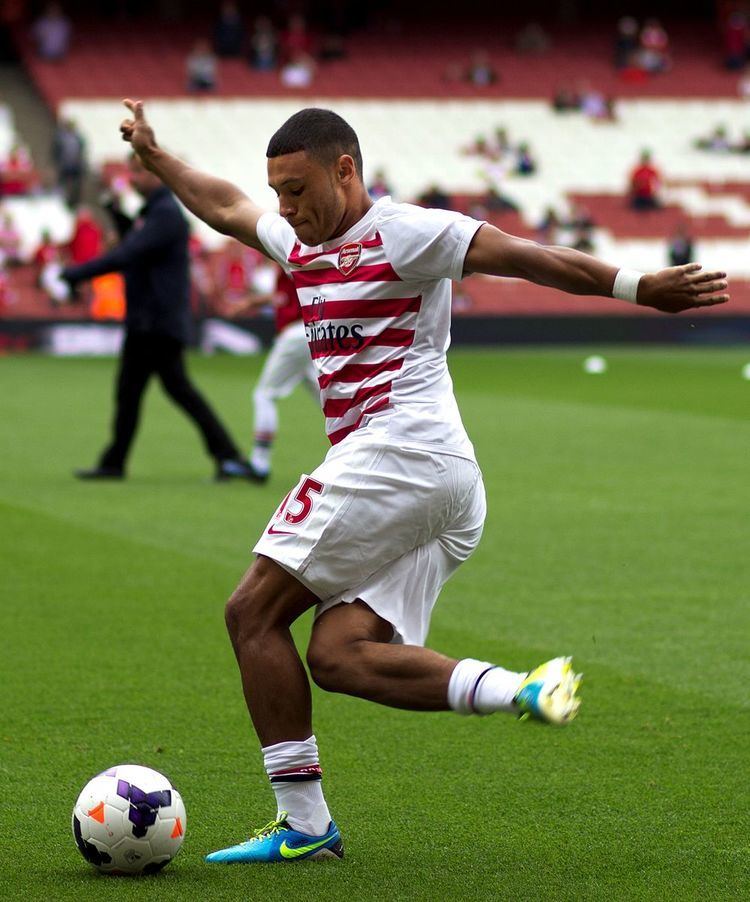 | ||
In association football, the rabona is a method of kicking the football whereby the kicking leg is wrapped around the back of the standing leg–effectively with one's legs crossed.
Contents
There are several reasons why a player might opt to strike the ball this way: for example, a right-footed striker advancing towards the goal slightly on the left side rather than having the goal straight in front may feel that his shot power or accuracy with his left foot is inadequate, so will perform a rabona in order to take a better shot. Another scenario could be a right-footed winger sending a cross while playing on the left side of the pitch without having to turn first. Another reason why a player could perform a rabona might be to confuse a defending player, or simply to show off his own ability, as it is considered a skillful trick at any level.
History
Rabona in Spanish means to play hooky, to skip school. The name derives from its first documented performance by Ricardo Infante in a game between Argentinian teams Estudiantes de la Plata and Rosario Central in 1948. The football magazine El Gráfico published a front cover showing Infante dressed as a schoolboy with the caption "El infante que se hizo la rabona" (In English: "The infant plays hooky"). Another supposed origin for the name is that Rabona is derived from the Spanish world rabo for tail, and that the move resembled the swishing of a cow's tail between or around its legs. In Brazil, the move is also known as the chaleira (kettle) or letra (letter).
The first filmed rabona was performed by Brazilian footballer Pelé in the São Paulo state championship in 1957. Giovanni "Cocò" Roccotelli is credited with popularising the rabona in Italy during the 1970s; at the time, this move was simply called a "crossed-kick" (incrociata, in Italian).
In addition to the aforementioned players, some examples of various well known exponents of the rabona, who have successfully performed the skill in competitions and are also known to employ it frequently during matches, are: Diego Maradona, Roberto Baggio, Cristiano Ronaldo, Ronaldinho, Claudio Borghi, Matías Fernández, Matías Urbano, Mário Jardel, David Villa, Ariel Ortega, Robinho, Alberto Aquilani, Eden Hazard, Joe Cole, Ángel Di María, Rivaldo, Ricardo Quaresma, Érik Lamela, Pablo Aimar, Gianfranco Zola, Roberto Carlos, Neymar, Luis Suárez, and Jay-Jay Okocha. Other players who have also used this skill successfully during a competitive match are: Andrés Vasquez, Djalminha, Fahad Al Enezi, Thomas Müller, Manolis Skoufalis, Léo Lima, Marcos Rojo, Marcelo Carrusca. Dimitri Payet, Carlos Bacca, Fabrizio Miccoli, Jonathan Calleri, and Diego Perotti, among many others; Johnny Giles of Leeds United also performed one in the famous sequence of possession against Southampton in the late 1970s during the 7–0 win.
Other sports and uses
The first known use of the rabona in American football was done by Dallas Cowboys placekicker Toni Fritsch, who was a former soccer player that used it late in the fourth quarter of the 1972 NFC Divisional playoffs during an onside kick, that contributed to a historic come from behind 30–28 victory against the San Francisco 49ers. Also used by Rice University placekicker Chris Boswell to successfully deceive his opponents, the University of Houston during an onside kick. Boswell had learned the trick from his father, who grew up playing association football in Brazil. On November 6, 2016, Boswell had an unsuccessful rabona kick in the NFL for the Pittsburgh Steelers, who were playing against the Baltimore Ravens. Kansas State University placekicker Matthew McCrane attempted an unsuccessful rabona onside kick in the 2015 Alamo Bowl.
The rabona is also a dance step used in the tango. The dance step takes its name from the football kick.
